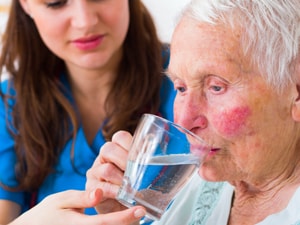Choosing Exercises for Dysphagia Treatment: An Evidence-Based Approach
February 3, 2021
5 min. read

Helping to rehabilitate someone with dysphagia so the person can eat and drink safely and in the most effective means can be quite a rewarding experience.
When choosing the most appropriate exercise routine or plan of care for each patient, we have to keep several things in mind. First, we need an accurate assessment to determine the physiology and dysfunction of the swallow. This includes a complete clinical swallow evaluation with a complete history and chart/records review, brief cognitive exam, oral motor exam, and a thorough cranial nerve exam.
We can then make the appropriate recommendation for an instrumental exam, whether it be FEES or VFSS to determine the pharyngeal physiology.
The Principles of Neuroplasticity
When we are creating a dysphagia treatment plan, we need to be mindful not only of the swallowing physiology and dysfunctionwhether it be sensory or motor drivenbut we also need to remember the principles of neuroplasticity and exercise physiology.
The principles of neuroplasticity should drive our therapy plan. These principles include:
Use it or lose it
Use it and improve it
Experience specificity
Repetition
Intensity
Duration
Salience
Patient's age
Transference
Interference
We also need to be mindful that when we are rehabilitating the swallow, we need to have the patient practice swallowing. This means including exercises that are swallow-driven. Exercises such as repeating words that begin with /k/ or /g/ or tongue movements are not swallow-driven.
We also need to make sure that we are increasing the repetition and intensity of the prescribed exercise. Think about the principle of use it or lose it and how it relates to those patients who are strict NPO.
The Principles of Exercise Science
When we prescribe exercises for our patients, are we using exercise science? Exercise science principles include:
Individuality
Trainability
Specificity
Progression
Overload
Variety
Rest
Adaptation
Recovery
Reversibility
Maintenance
Ceiling
Not every patient will require exercises for strengthening since not every patient with dysphagia has a strength issue. But when you are working to strengthen swallowing muscles, you should incorporate the following in your exercise plan:
Resistance
Speed
Repetition
Intensity
Load
Pacing
Fatigue
Exercises need to progress and require resistance and intensity to increase strength. Simple range-of-motion exercises such as sticking out your tongue with no resistance do not lead to increased swallow strength.
Top Dysphagia Exercises PDF
Fill out the form to unlock your free Dysphagia Exercise Handout PDF!
Unlock Resource
Exercise Plans for Swallowing Concerns
Often, exercise programs or pages of exercises are passed down in a facility and used for years with no adaptation to current evidence or changes to individualize the exercises to suit the patients needs.
Try these exercise plans for the following swallowing issues, featuring exercises available in Medbridge's HEP library.
Sensory Aspect of Swallowing
Carbonated beverages, which may increase speed of the swallow through sensation
Changes in flavor, which may increase sensory input of the swallow, driving the motor output
External pressure to the cheek or to the tongue, for example by using a spoon
Changes in temperature
Changes in texture
Changes in the size of the bolus, which may increase load of the bolus, thereby increasing the sensory component of the swallow, which many elderly patients need. Increased bolus size may also help to drive the UES opening.
Decreased Labial Closure
Labial press, by holding a tongue depressor between the lips during swallowing exercises
Straw drinking, decreasing the size of the straw to make the task more difficult
Decreased Lingual Control
Lingual exercises with resistance using the IOPI, the Tongue-O-Meter, or tongue depressors
Effortful swallow, in which the patient swallows as hard as they can while squeezing the pharyngeal muscles as tightly as possible
Base-of-tongue exercises, including yawning, pretending to gargle, pulling the tongue straight back in the mouth
Lingual exercises with resistance, such as pushing the tongue out, up, and to each side against a tongue depressor
Reduced Velopharyngeal Closure
Expiratory muscle strength training (EMST) using a pressure threshold device, such as the EMST 150, in which the patient follows a protocol provided with the device
Reduced Hyolaryngeal Excursion
Chin tuck against resistance (CTAR) using a 12-cm ball, the Phagiaflex, or a rolled towel. Have the patient push their chin down against the tool and hold for one minute, then rest for one minute, and repeat this three times. You can also have the patient push down repetitively 30 times.
Shaker maneuver, in which the patient lies flat on their back and holds their head up, holding the pose for one minute, resting for one minute, and repeating this three times. The patient can also repetitively lift their head 30 times.
Effortful swallow
Mendelsohn maneuver, by having the patient hold their Adams apple up for as long as possible after completion of the swallow to keep the airway closed after the swallow. View this during VFSS to ensure accuracy of completion of the exercise.
Jaw opening against resistance (JOAR), in which a tool is held in CTAR or the patient holds their hand under their jaw. Have the patient open their mouth as wide as possible for a count of 10 and then close the mouth for a count of 10. Complete five repetitions, two times a day, for four weeks.
Pitch glide, in which the patient starts at a low pitch and slowly increases their pitch to the highest level and holds for several seconds
Reduced Laryngeal Closure
Super supraglottic swallow, in which the patient takes a deep breath, holds their breath after the inhale, and bears down while swallowing hard and coughing immediately following the swallow
EMST
Reduced Pharyngeal Contraction
Effortful swallow
CTAR
Shaker
Mendelsohn maneuver
Reduced UES/PES (Pharyngoesophageal segment) Opening
Shaker
Effortful swallow
Mendelsohn maneuver
CTAR
JOAR
There are also several treatment protocols requiring specialized training that will guide you in decision making as to when to use the protocol and who would most benefit from it. These programs include:
Neuromuscular electrical stimulation (VitalStim, Guardian, eSwallow)
There is also research supporting Pharyngocise for patients with head and neck cancer.
Regularly addressing and updating your exercise prescription techniques based on the most current evidence will help keep you practicing at the top of your license and providing your patients with the best chances to regain lost function.
Below, watch Angela Mansolillo discuss the exercise Effortful Swallow in a short clip from her MedBridge course, "Dysphagia and the Older Adult: Exercise in Swallow Rehabilitation."






